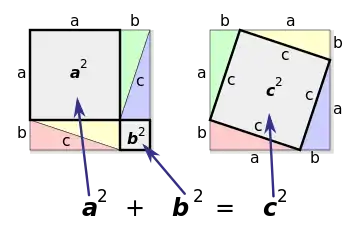< Portal:Mathematics < Featured picture

Portal:Mathematics/Featured picture/2010 09
Picture of the month

Credit: Shell-man
The Pythagorean theorem, or Pythagoras's theorem, relates the lengths of the three sides of a right triangle, and states:
- In any right triangle, the area of the square whose side is the hypotenuse (the side opposite the right angle) is equal to the sum of the areas of the squares whose sides are the two legs (the two sides that meet at a right angle).
There are many proofs of the theorem, dating back to Ancient Greek mathematician Pythagoras, who is credited with its discovery. The above diagram shows a geometric proof.
| ...Archive | Read more... |
This article is issued from Wikipedia. The text is licensed under Creative Commons - Attribution - Sharealike. Additional terms may apply for the media files.